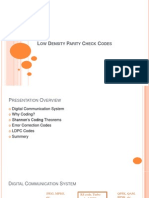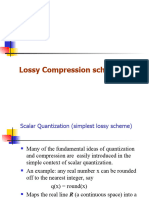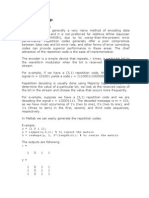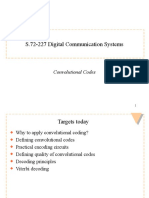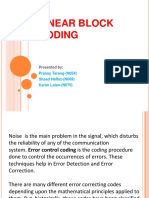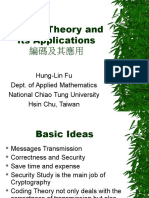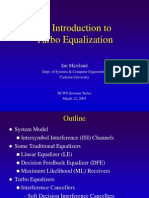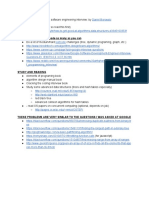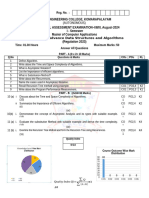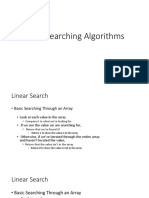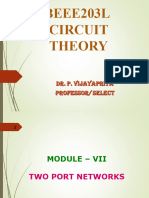LDPC Optimization
LDPC Optimization
Uploaded by
Shajeer KaniyapuramCopyright:
Available Formats
LDPC Optimization
LDPC Optimization
Uploaded by
Shajeer KaniyapuramOriginal Title
Copyright
Available Formats
Share this document
Did you find this document useful?
Is this content inappropriate?
Copyright:
Available Formats
LDPC Optimization
LDPC Optimization
Uploaded by
Shajeer KaniyapuramCopyright:
Available Formats
The Role of Specialization in
LDPC Codes
Jeremy Thorpe
Pizza Meeting Talk
2/12/03
Talk Overview
LDPC Codes
Message Passing Decoding
Analysis of Message Passing Decoding
(Density Evolution)
Approximations to Density Evolution
Design of LDPC Codes using D.E.
The Channel Coding Strategy
Encoder chooses the m
th
codeword in codebook C
and transmits it across the
channel
Decoder observes the
channel output y and
generates m based on the
knowledge of the codebook
C and the channel
statistics.
Decoder
Encoder
Channel
k
} 1 , 0 { 'e m
n
Y e y
n
X C c e x
k
} 1 , 0 { e m
Linear Codes
A linear code C (over a finite field) can be
defined in terms of either a generator matrix
or parity-check matrix.
Generator matrix G (kn)
Parity-check matrix H (n-kn)
} {mG = C
} ' : { 0 cH c = = C
LDPC Codes
LDPC Codes -- linear codes defined in terms
of H.
H has a small average number of non-zero
elements per row
1 0 1 1 0 0 1 0 0 1
0 1 0 0 1 1 1 0 1 0
0 1 1 1 0 1 0 0 1 1
1 1 0 0 0 0 1 1 0 1
0 0 0 0 1 0 0 1 1 0
= H
Graph Representation of LDPC
Codes
H is represented by a
bipartite graph.
There is an edge from
v to c if and only if:
A codeword is an
assignment of v's s.t.:
c x
c v
v
=
0
|
.
.
.
.
.
.
Variable nodes
Check nodes
0 ) , ( = c v H
Regular (,) LDPC codes
Every variable node
has degree , every
check node has degree
.
Ensemble is defined by
matching left edge
"stubs" with right edge
"stubs via a random
permutation
.
.
.
.
.
.
Variable nodes
Check nodes
Message-Passing Decoding of
LDPC Codes
Message Passing (or Belief Propagation)
decoding is a low-complexity algorithm
which approximately answers the question
what is the most likely x given y?
MP recursively defines messages m
v,c
(i)
and
m
c,v
(i)
from each node variable node v to each
adjacent check node c, for iteration i=0,1,...
Two Types of Messages...
Liklihood Ratio
For y
1
,...y
n
independent
conditionally on x:
Probability Difference
For x
1
,...x
n
independent:
) 0 | (
) 1 | (
,
=
=
=
x y p
x y p
y x
) | 0 ( ) | 1 (
,
y x p y x p
y x
= = =
[
=
i
y x
y x i
n
,
,
1
[
=
i
y x y
i
x
i i
, ,
...Related by the Biliniear
Transform
Definition:
Properties:
x
x
x B
+
=
1
1
) (
y x
y x
y x p y x p
y p
y p y x p y p y x p
y p
x y p x y p
x y p x y p
x y p x y p
x y p
x y p
B B
,
,
) | 1 ( ) | 0 (
) ( 2
) ( ) | 1 ( 2 ) ( ) | 0 ( 2
) ( 2
) 1 | ( ) 0 | (
) 1 | ( ) 0 | (
) 1 | ( ) 0 | (
)
) 0 | (
) 1 | (
( ) (
=
= = =
= =
=
= =
=
= + =
= =
=
=
=
=
y x y x
y x y x
B
B
x x B B
, ,
, ,
) (
) (
)) ( (
=
=
=
Message Domains
Likelihood Ratio
Log Likelihood Ratio Log Prob. Difference
Probability Difference
) 1 | (
) 0 | (
=
=
x y P
x y P
) | 1 ( ) | 0 ( y x P y x P = =
) ( B
) ( ' B
Variable to Check Messages
On any iteration i, the
message from v to c is:
It is computed like:
) (
) 1 (
' |
, ' ,
) (
,
=
[
=
i
c v c
v c y x
i
c v
m B m
v v
.
.
.
.
.
.
v
c
) 0 | (
) 1 | (
=
=
x e P
x e P
Check to Variable Messages
On any iteration, the
message from c to v is:
It is computed like:
Assumption: Incoming
messages are indep.
) (
) (
' |
, '
) (
,
i
v c v
c v
i
v c
m B m
[
=
=
.
.
.
.
.
.
v
c ) | 1 ( ) | 0 ( e v P e v P = =
Decision Rule
After sufficiently many iterations, return the
likelihood ratio:
<
=
[
otherwise , 1
0 ) ( if , 0
) 1 (
|
, ,
i
v c
v c y x
m B
x
v v
Theorem about MP Algorithm
If the algorithm stops after r
iterations, then the algorithm
returns the maximum a
posteriori probability estimate
of x
v
given y within radius r of
v.
However, the variables within
a radius r of v must be
dependent only by the
equations within radius r of v,
v
r
.
.
.
.
.
.
.
.
.
Analysis of Message Passing
Decoding (Density Evolution)
in Density Evolution we keep track of
message densities, rather than the densities
themselves.
At each iteration, we average over all of the
edges which are connected by a permutation.
We assume that the all-zeros codeword was
transmitted (which requires that the channel
be symmetric).
D.E. Update Rule
The update rule for Density Evolution is
defined in the additive domain of each type
of node.
Whereas in B.P, we add (log) messages:
In D.E, we convolve message densities:
=
=
v c v
i
c v
i
v c
m B m
' |
) (
, '
) (
,
) ( '
[
=
=
v c v
i
c v
i
v c
m D B m D
' |
) (
, '
) (
,
)) ( ( '
*
) (
Familiar Example:
If one die has density function given by:
The density function for the sum of two dice
is given by the convolution:
1 3 6 5 4 2
2 4 7 6 5 3 8 10 12 11 9
D.E. Threshold
Fixing the channel message densities, the
message densities will either "converge" to
minus infinity, or they won't.
For the gaussian channel, the smallest
(infimum) SNR for which the densities
converge is called the density evolution
threshold.
Regular (,) LDPC codes
Every variable node has degree , every
check node has degree .
Best rate 1/2 code is (3,6), with threshold
1.09 dB.
This code had been invented by 1962 by
Robert Gallager.
D.E. Simulation of (3,6) codes
Set SNR to 1.12 dB
(.03 above threshold)
Watch fraction of
"erroneous messages"
from check to variable.
(note that this fraction
does not characterize
the distribution fully)
Improvement vs. current error
fraction for Regular (3,6)
Improvement per
iteration is plotted
against current error
fraction.
Note there is a single
bottleneck which took
most of the decoding
iterations.
Irregular (, ) LDPC codes
a fraction
i
of variable
nodes have degree i.
i
of check nodes have
degree i.
Edges are connected by
a single random
permutation.
Nodes have become
specialized.
.
.
.
.
.
.
Variable nodes
Check nodes
3
m
D.E. Simulation of Irregular
Codes (Maximum degree 10)
Set SNR to 0.42 dB
(~.03 above threshold)
Watch fraction of
erroneous check to
variable messages.
This Code was
designed by
Richardson et. al.
Comparison of Regular and
Irregular codes
Notice that the
Irregular graph is much
flatter.
Note: Capacity
achieving LDPC codes
for the erasure channel
were designed by
making this line
exactly flat.
Multi-edge-type construction
Edges of a particular
"color" are connected
through a permutation.
Edges become
specialized. Each edge
type has a different
message distribution
each iteration.
D.E. of MET codes.
For Multi-edge-type
codes, Density
evolution tracks the
density of each type of
message separately.
Comparison was made
to real decoding, next
slide (courtesy of Ken
Andrews).
MET D.E. vs. decoder
simulation
Regular, Irregular, MET
comparison
Multi-edge-type LDPC
codes improve
gradually through most
of the decoding.
MET codes have a
threshold below the
more "complex"
irregular codes.
Design of Codes using D.E.
Density evolution provides a moderately fast
way to evaluate single- and multi- edge type
degree distributions (hypothesis-testing).
Much faster approximations to Density
Evolution can easily be put into an outer loop
which performs function minimization.
Semi-Analytic techniques exist as well.
Review
Iterative Message Passing can be used to
decode LDPC codes.
Density Evolution can be used to predict the
performance of MP for infinitely large codes.
More sophisticated classes of codes can be
designed to close the gap to the Shannon
limit.
Beyond MET Codes
(future work)
Traditional LDPC codes are designed in two stages:
design of the degree distribution and design of the
specific graph.
Using very fast and accurate approximations to
density evolution, we can evaluate the effect of
placing or removing a single edge in the graph.
Using an evolutionary algorithm like Simulated
Annealing, we can optimize the graph directly,
changing the degree profile as needed.
You might also like
- Low Density Parity Check Codes1Document41 pagesLow Density Parity Check Codes1Prithvi RajNo ratings yet
- Low Density Parity Check CodesDocument21 pagesLow Density Parity Check CodesPrithvi Raj0% (1)
- Lossy Compression Iii - 1Document21 pagesLossy Compression Iii - 1Rakesh InaniNo ratings yet
- Error Control Coding3Document24 pagesError Control Coding3DuongMinhSOnNo ratings yet
- Unit Iv Linear Block Codes: Channel EncoderDocument26 pagesUnit Iv Linear Block Codes: Channel EncoderSudhaNo ratings yet
- A Bit-Serial Approximate Min-Sum LDPC Decoder - Chan Carusone A University of TorontoDocument4 pagesA Bit-Serial Approximate Min-Sum LDPC Decoder - Chan Carusone A University of Torontoelaheh.hassanzadeh6No ratings yet
- Information Theory and CodingDocument9 pagesInformation Theory and Codingsunilnkkumar100% (1)
- Digital Communication Coding: En. Mohd Nazri Mahmud Mphil (Cambridge, Uk) Beng (Essex, Uk)Document25 pagesDigital Communication Coding: En. Mohd Nazri Mahmud Mphil (Cambridge, Uk) Beng (Essex, Uk)Apram SinghNo ratings yet
- Linear Block CodingDocument18 pagesLinear Block CodingPavuluri SairamNo ratings yet
- Speech Coding SystemsDocument90 pagesSpeech Coding SystemsboogamiNo ratings yet
- Chapter 8-b Lossy Compression AlgorithmsDocument18 pagesChapter 8-b Lossy Compression AlgorithmsfarshoukhNo ratings yet
- Tornado Codes and Luby Transform Codes PDFDocument12 pagesTornado Codes and Luby Transform Codes PDFpathmakerpkNo ratings yet
- Agniel 2Document14 pagesAgniel 2Killer Boys7No ratings yet
- Difference To Sum Ratio Factor Based Min-Sum Decoding For Low Density Parity Check CodesDocument6 pagesDifference To Sum Ratio Factor Based Min-Sum Decoding For Low Density Parity Check CodesMishuk MawlaNo ratings yet
- Error Correcting CodesDocument38 pagesError Correcting CodeshmbxNo ratings yet
- SC 12Document45 pagesSC 12Warrior BroNo ratings yet
- Detecting Bit Errors: EctureDocument6 pagesDetecting Bit Errors: EctureaadrikaNo ratings yet
- Convolutional Codes Turbo Codes LDPC CodesDocument49 pagesConvolutional Codes Turbo Codes LDPC CodesveerutheprinceNo ratings yet
- Error Correction CodesDocument29 pagesError Correction Codesowassim236No ratings yet
- Channel Coding: Binit Mohanty Ketan RajawatDocument16 pagesChannel Coding: Binit Mohanty Ketan Rajawatsam mohaNo ratings yet
- Channel CodingDocument16 pagesChannel Codingowassim236No ratings yet
- Chapter 8 MmediaDocument18 pagesChapter 8 MmediaAbraham AbaynehNo ratings yet
- 18ec501 U5lm1Document28 pages18ec501 U5lm1DHANUSHRAGAV MNo ratings yet
- Channel CodingDocument4 pagesChannel CodingNazish KhanNo ratings yet
- S.72-227 Digital Communication Systems: Convolutional CodesDocument26 pagesS.72-227 Digital Communication Systems: Convolutional Codesjoydeep12No ratings yet
- DC AssignDocument13 pagesDC AssignSp PriyaNo ratings yet
- Type of Errors: Random Errors and Burst ErrorsDocument9 pagesType of Errors: Random Errors and Burst Errorsisrael_zamora6389No ratings yet
- Channelcoding: Dept. of Electrical & Computer Engineering The University of Michigan-DearbornDocument54 pagesChannelcoding: Dept. of Electrical & Computer Engineering The University of Michigan-DearbornJohn PragasamNo ratings yet
- Linear Block Coding: Presented byDocument12 pagesLinear Block Coding: Presented bypranay639No ratings yet
- Experimental Verification of Linear Block Codes and Hamming Codes Using Matlab CodingDocument17 pagesExperimental Verification of Linear Block Codes and Hamming Codes Using Matlab CodingBhavani KandruNo ratings yet
- Burst Error Correcting Code For Protecting On-Chip Memory Systems Against Multiple Cell UpsetsDocument5 pagesBurst Error Correcting Code For Protecting On-Chip Memory Systems Against Multiple Cell UpsetsInternational Journal of Application or Innovation in Engineering & ManagementNo ratings yet
- LDPC-optimizationDocument32 pagesLDPC-optimizationĐặng Hoài SơnNo ratings yet
- Low-Density Parity-Check Codes Over Gaussian Channels With ErasuresDocument9 pagesLow-Density Parity-Check Codes Over Gaussian Channels With ErasuresBoazShuvalNo ratings yet
- Coding Theory and Its ApplicationsDocument45 pagesCoding Theory and Its Applicationsnavisingla100% (1)
- CT216 Exam 2Document6 pagesCT216 Exam 2202201580daiict.ac.inNo ratings yet
- 5CS3-01: Information Theory & Coding: Unit-3 Linear Block CodeDocument75 pages5CS3-01: Information Theory & Coding: Unit-3 Linear Block CodePratapNo ratings yet
- LDPCDocument20 pagesLDPCRahul KumarNo ratings yet
- Viterbi DecodingDocument4 pagesViterbi DecodingGaurav NavalNo ratings yet
- LDPCDocument5 pagesLDPCM A DiptoNo ratings yet
- An Introduction To Turbo Equalization: Ian MarslandDocument36 pagesAn Introduction To Turbo Equalization: Ian MarslandhahutNo ratings yet
- 10 ErrorDocument51 pages10 Errorベラ ジェークNo ratings yet
- Fundamentals of Computer Networks ECE 478/578Document15 pagesFundamentals of Computer Networks ECE 478/578blesson123No ratings yet
- UNIT5 Part 2-1-19Document19 pagesUNIT5 Part 2-1-19Venkateswara RajuNo ratings yet
- UNIT5 Part 2Document54 pagesUNIT5 Part 2Venkateswara RajuNo ratings yet
- UNIT5 Part 2-1-35Document35 pagesUNIT5 Part 2-1-35Venkateswara RajuNo ratings yet
- ELG 5372 Error Control CodingDocument453 pagesELG 5372 Error Control Codingremonadly2704No ratings yet
- DC Unit Test 2 Question BankDocument4 pagesDC Unit Test 2 Question BankSiva KrishnaNo ratings yet
- WalshDocument4 pagesWalshonlineanil007No ratings yet
- Performance Analysis of Reed-Solomon Codes Concatinated With Convolutional Codes Over Awgn ChannelDocument6 pagesPerformance Analysis of Reed-Solomon Codes Concatinated With Convolutional Codes Over Awgn ChannelkattaswamyNo ratings yet
- LT Erasure CodesDocument10 pagesLT Erasure CodesCosmo SeedsNo ratings yet
- Convolution CodesDocument14 pagesConvolution CodeskrishnaNo ratings yet
- Experiment No.5: Title: Aim: Apparatus: Theory: (1) Explain Linear Block Codes in DetailDocument8 pagesExperiment No.5: Title: Aim: Apparatus: Theory: (1) Explain Linear Block Codes in Detailabdulla qaisNo ratings yet
- EXIT Chart Based Design of LDPC Codes For Higher OrderDocument5 pagesEXIT Chart Based Design of LDPC Codes For Higher Orderchaudhryadnanaslam3799No ratings yet
- 605 Ass and Quiz 2011Document24 pages605 Ass and Quiz 2011Rohan JainNo ratings yet
- EXIT Charts For Non-Binary LDPC Codes Over Arbitrary Discrete-Memoryless ChannelsDocument5 pagesEXIT Charts For Non-Binary LDPC Codes Over Arbitrary Discrete-Memoryless Channelsnomore891No ratings yet
- Vector QuantizationDocument12 pagesVector QuantizationEr Paramjit SinghNo ratings yet
- LDPC Tutorial Mod1Document55 pagesLDPC Tutorial Mod1Tuan VuNo ratings yet
- DSP R09 April 2018Document30 pagesDSP R09 April 2018suneel laxmipuramNo ratings yet
- Line Drawing Algorithm: Mastering Techniques for Precision Image RenderingFrom EverandLine Drawing Algorithm: Mastering Techniques for Precision Image RenderingNo ratings yet
- Representasi Sinyal 02Document26 pagesRepresentasi Sinyal 02Ilham DirgantaraNo ratings yet
- MD. Mahadi Hasan SajibDocument7 pagesMD. Mahadi Hasan SajibMortuzaNo ratings yet
- SWE Job Interview Prep ResourcesDocument2 pagesSWE Job Interview Prep ResourcesHari Madhavan Krishna Kumar100% (1)
- Soln1 PsDocument6 pagesSoln1 PsRafran Rosly100% (1)
- IAE - 1 Question Paper For ADSA Set-1Document2 pagesIAE - 1 Question Paper For ADSA Set-1Usri DeviNo ratings yet
- Measuring The Effects of Non-Identical Data Distribution For Federated Visual ClassificationDocument5 pagesMeasuring The Effects of Non-Identical Data Distribution For Federated Visual ClassificationKI R ANNo ratings yet
- CP4252 Machine Learning Lab ManualDocument26 pagesCP4252 Machine Learning Lab ManualPrakash JeevaNo ratings yet
- Cse 408 AssignmentDocument14 pagesCse 408 AssignmentHitesh SahaniNo ratings yet
- Informed Search ProblemsDocument38 pagesInformed Search ProblemsTayyab NaveedNo ratings yet
- NUMERICALSDocument6 pagesNUMERICALSMarifer CavintaNo ratings yet
- ELM TutorialDocument177 pagesELM TutorialrameshragalaNo ratings yet
- Course: DD2427 - Exercise Class 1: Exercise 1 Motivation For The Linear NeuronDocument5 pagesCourse: DD2427 - Exercise Class 1: Exercise 1 Motivation For The Linear Neuronscribdtvu5No ratings yet
- PDF Evolutionary Optimization Algorithms Full Online: Book DetailsDocument1 pagePDF Evolutionary Optimization Algorithms Full Online: Book Detailskwik1804No ratings yet
- Chapter 4 MultiDocument45 pagesChapter 4 Multiadu gNo ratings yet
- Basic Searching AlgorithmsDocument16 pagesBasic Searching AlgorithmsWASEEM HAIDER1No ratings yet
- Module 5Document2 pagesModule 5Sejal AroraNo ratings yet
- Dafx14 Aaron Wishnick Time Varying Filters ForDocument8 pagesDafx14 Aaron Wishnick Time Varying Filters ForAdrián BuenfilNo ratings yet
- C.V. Raman Global University: Bidyanagar, Mahura, Janla, Bhubaneswar, Odisha-752054Document30 pagesC.V. Raman Global University: Bidyanagar, Mahura, Janla, Bhubaneswar, Odisha-752054Saket AnandNo ratings yet
- Lecture 6Document41 pagesLecture 6Sher Afghan MalikNo ratings yet
- Data Mining Cluster Analysis: Basic Concepts and AlgorithmsDocument26 pagesData Mining Cluster Analysis: Basic Concepts and AlgorithmsazzaNo ratings yet
- Maximum Circular Subarray SumDocument3 pagesMaximum Circular Subarray SumvacacNo ratings yet
- 315-Fall 2022Document1 page315-Fall 2022Furkan KÖROĞLUNo ratings yet
- DddssDocument5 pagesDddssPrakhar RajputNo ratings yet
- NewtonsbackwardDocument5 pagesNewtonsbackwardRayhan KhanNo ratings yet
- Tournament TreesDocument39 pagesTournament Treesvinitha_reddyNo ratings yet
- Interconnection Between NetworksDocument15 pagesInterconnection Between Networksthamilmaran alwarNo ratings yet
- MatlabDocument7 pagesMatlabshylaja_pNo ratings yet
- 1.basic Element and Classification of DSP PDFDocument29 pages1.basic Element and Classification of DSP PDFIndervir SinghNo ratings yet
- Lecture09 - Numerical Integration (I)Document25 pagesLecture09 - Numerical Integration (I)Na2ryNo ratings yet
